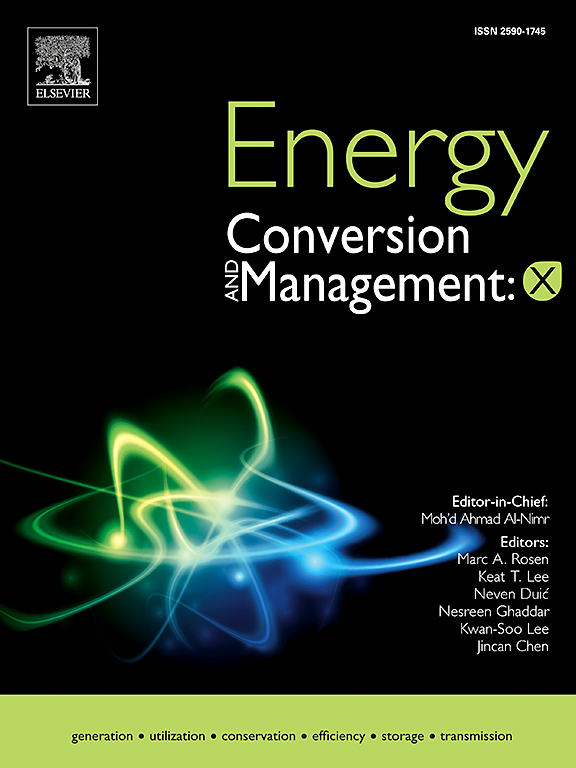以甘油为氢供体,使用氧化锆镍钼催化剂从棕榈油脱氧中生产生物燃料
IF 7.1
Q1 ENERGY & FUELS
引用次数: 0
摘要
由于对可再生能源的需求日益增长,人们对生物燃料作为化石燃料的替代品产生了浓厚的兴趣。从脱氧油脂中提取的第二代生物燃料,由于具有直接替代柴油和喷气燃料的潜力,受到了工业界和学术界的高度关注。棕榈油主要在泰国种植,由 C16 和 C18 脂肪酸组成,是生物燃料生产的主要原料。棕榈油脱氧包含几种途径,可能需要也可能不需要氢气。本研究旨在利用甘油作为氢源,通过棕榈油脱氧生产不同燃料范围的生物燃料,如汽油、喷气燃料和柴油。甘油是一种低价值的副产品,被用作氢气供体,而镍钼支撑催化剂因其脱氧效率高和成本效益高而被选用。研究调查了反应时间、温度和催化剂活化方法对棕榈油脱氧的影响。催化剂表征方法包括 XRD、SEM、TEM、XPS、FTIR、TGA 和氮吸附,以了解催化剂在棕榈油升级过程中的活性作用。研究结果表明,液体产品中的主要成分是烷烃。反应后气相中过量氢的存在证明了甘油的供氢能力。增加反应时间和温度有利于去除棕榈油中的氧气。通过硫化活化氧化锆上的镍钼比通过还原活化表现出更高的稳定性。本文章由计算机程序翻译,如有差异,请以英文原文为准。
Biofuel production from palm oil deoxygenation using nickel-molybdenum on zirconia catalyst using glycerol as a hydrogen donor
The growing demand for renewable energy has generated interest in biofuels as alternatives to fossil fuels. Second-generation biofuels, derived from deoxygenating fats and oils, have garnered a higher level of interest from industry and academia due to their potential for direct replacement of diesel and jet fuels. Palm oil, mostly cultivated in Thailand and composed of C16 and C18 fatty acids, is a primary feedstock sought for biofuel production. Palm oil deoxygenation contains several pathways that may or may not require hydrogen gas. This study aimed to produce biofuels in different fuel ranges, such as gasoline, jet fuel, and diesel, through palm oil deoxygenation using glycerol as a hydrogen source. Glycerol, a low-value byproduct, was used as a hydrogen donor, whereas nickel-molybdenum-supported catalysts were chosen for their high efficiency in deoxygenation and cost-effectiveness. The study investigated the impact of reaction time, temperature, and catalyst activation method on palm oil deoxygenation. Catalyst characterization methods, including XRD, SEM, TEM, XPS, FTIR, TGA, and nitrogen-sorption, were employed to understand the role of catalysts’ activity during palm oil upgrading. Findings indicated that alkane hydrocarbons are the major components in liquid products. The presence of excess hydrogen in post reaction gaseous phase proves the hydrogen donation capability of glycerol. Increased reaction time and temperature facilitated the removal of oxygen from palm oil. Nickel-molybdenum on zirconia activated by sulfidation demonstrated higher stability than by reduction activation.
求助全文
通过发布文献求助,成功后即可免费获取论文全文。
去求助
来源期刊

Energy Conversion and Management-X
Multiple-
CiteScore
8.80
自引率
3.20%
发文量
180
审稿时长
58 days
期刊介绍:
Energy Conversion and Management: X is the open access extension of the reputable journal Energy Conversion and Management, serving as a platform for interdisciplinary research on a wide array of critical energy subjects. The journal is dedicated to publishing original contributions and in-depth technical review articles that present groundbreaking research on topics spanning energy generation, utilization, conversion, storage, transmission, conservation, management, and sustainability.
The scope of Energy Conversion and Management: X encompasses various forms of energy, including mechanical, thermal, nuclear, chemical, electromagnetic, magnetic, and electric energy. It addresses all known energy resources, highlighting both conventional sources like fossil fuels and nuclear power, as well as renewable resources such as solar, biomass, hydro, wind, geothermal, and ocean energy.
 求助内容:
求助内容: 应助结果提醒方式:
应助结果提醒方式:


